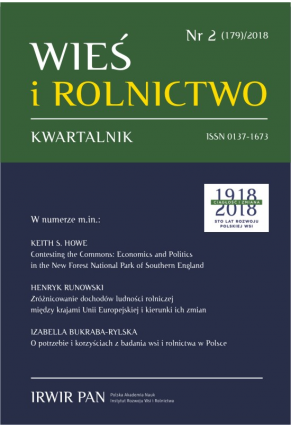Auxiliary Farms and the Use of Agricultural Land
DOI:
https://doi.org/10.53098/wir022018/08Keywords:
agricultural land use, agricultural land use level, auxiliary farmsAbstract
The purpose of the article is to verify a hypothesis that non-agricultural activities of farm holders limit significantly the extent to which agricultural land is used for agricul tural production. The hypothesis has been verified based on materials describing the agricultural situation in 2013 in Poland and in twelve other European Union Member States differing in terms of GDP per capita. The analysis covered farms referred to as ‘auxiliary farms’, i.e. farms, whose holders spend more than half of their working time doing some other paid job. It was concluded that on auxiliary farms in Poland the value of the so-called standard output per 1 ha of farmland was lower, on average, by 34% than on other farms and in the subgroups which differed in terms of the area of farmland, this difference ranged from 25.3% to 40.1%. In the majority of the other Member States under analysis, the average national differences ranged from 22.3% to 49.7%. The results concerning auxiliary farms in the countries in which GDP per capita was lower than USD 9.5 thousand (Bulgaria and Romania) deviated from this situation. The average value of the standard output on auxiliary farms was by 45% higher there than on other farms. It has been indicated that the reason for this phenomenon could be the stocking density expressed in livestock units per farmland unit, which was higher on those auxiliary farms. Therefore, the hypothesis put forward in the article proved true in case of those farms whose holders spent more than half of their working time on additional paid job, which in turn reduced or forced the liquidation of livestock production.References
http://ec.europa.eu [dostęp: 13.11.2017].
Dudek M. (2016). Sukcesja indywidualnych gospodarstw rolnych jako czynnik przeobrażeń strukturalnych w polskim rolnictwie. Praca doktorska przygotowana pod kierunkiem prof. M.A. Sikorskiej, maszynopis. Warszawa: Instytut Ekonomiki Rolnictwa i Gospodarki Żywnościowej – PIB.
GUS (2014). Charakterystyka gospodarstw rolnych. Warszawa.
Józwiak W. (2016). Ocena możliwości rozwojowych małotowarowych gospodarstw rolnych wobec zmian klimatu i polityki gospodarczej, w opracowaniu zbiorowym. W: W. Józwiak (red.). Przedsiębiorstwa i gospodarstwa rolne wobec zmian klimatu i polityki rolnej (2) (s. 12–54) (seria Monografie Programu Wieloletniego, 28). Warszawa: Instytut Ekonomiki Rolnictwa i Gospodarki Żywnościowej – PIB.
Kędziora A. (2005). Przyrodnicze podstawy gospodarowania wodą w Polsce. W: L. Ryszkowski, A. Kędziora (red.). Ochrona środowiska w gospodarce przestrzennej (s. 75–113). Poznań: Zakład Badań Środowiska Rolniczego i Leśnego PAN.
Wojewodzic T. (2010). Zjawiska schyłkowe w gospodarstwach osób fizycznych i prawnych na obszarach Karpat Polskich. W: W. Musiał, W. Sroka, T. Wojewodzic (red.). Sytuacja ekonomiczna gospodarstw z terenów górskich i podgórskich (s. 53–76) (seria Program Wieloletni 2005–2009, 185). Warszawa: Instytut Ekonomiki Rolnictwa i Gospodarki Żywnościowej – PIB.
Żmija D. (2016). Wpływ wspólnej polityki rolnej Unii Europejskiej na funkcjonowanie małych gospodarstw rolnych. Warszawa: Difin.
Downloads
Article file downloads
Pages
How to Cite
Issue
Section
License
Copyright (c) 2018 Village and Agriculture

This work is licensed under a Creative Commons Attribution 4.0 International License.










